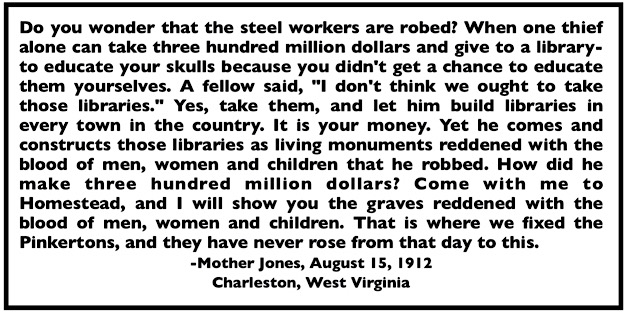 —————
—————
Hellraisers Journal – Sunday February 9, 1913
Carnegie’s Bloody “Pedestal of Fame” by Art Young
From The Coming Nation of February 8, 1913:
 —————
—————
Hellraisers Journal – Sunday February 9, 1913
Carnegie’s Bloody “Pedestal of Fame” by Art Young
From The Coming Nation of February 8, 1913:
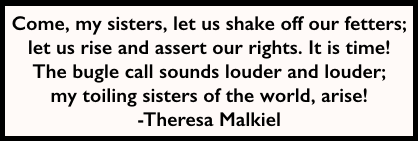 —————
—————
Hellraisers Journal – Monday January 27, 1913
New York, New York – Theresa Malkiel on Suffering of Garment Workers
From The Coming Nation of January 25, 1913:
Striking for the Right to Live
-by Theresa Malkiel
[Part II of III]
The clothing workers have suffered and starved, and, it must be admitted, tried to improve their condition by frequent strikes and attempts at organization. But their organizations, even as their strikes bore local character. One part of the trade, or one branch, or subdivision would go out on the warpath, but its struggle was doomed from the start, for the rest of the industry continued its work as if nothing had happened.
The German hated the Jew, the Jew the Italian, who is trying to wrench the trade from him, the Italian despised the Russian, the Russian the American, the cutter looked down upon the operator, the operator exploited the finisher, the finisher the helper, and while this was going on the employers exploited them all to their heart’s content.
The United Garment Workers of America, though considered the mother body of the clothing trade occupied themselves chiefly with one branch the overall-making, which is mostly in the hands of American women, and paid but little attention to the woes and sorrows of the tailors, perhaps, because the latter was considered beyond redemption.
Thus have men, women and children slaved for over seventy-five years. Thus have thousands upon thousands gone to their early graves, victims of consumption, heart disease, malnutrition, insanity. The man in charge of the claim department of the Workingman’s Circle, most of whose members are garment workers, told the writer that nine-tenths of their members died before they reached the age of forty.
And with the tailors the general public suffered. Unsanitary work-rooms, sweat-shop labor means infection of the garments, and eventually of the public who wear them. Our coats and suits were and still are made in places where smallpox, scarlet fever, diphtheria, measles, consumption and numerous other contagious diseases make great inroads. Our garments are made by workers themselves afflicted with disease, as a matter of fact, the workers in the sweat-shops and tenements not only work on the garments we wear, but often use them to sleep on or to cover themselves with.
Thus have ninety-two million people all over the country been subject to disease and contagion carried to them in their garments from Baltimore, Philadelphia, Chicago, Rochester and New York. For these cities produce 70 per cent of the entire output of man’s and children’s clothing, while New York alone produces one-third of the entire output.
New York was always the largest center in the clothing industry. The city has the natural advantages for production of all grades of clothing. Here, too, a large body of tailors land from Europe, and for the most part remain. The tailors form the nucleus for the better grades of work, while the hundreds of thousands of immigrants landing here yearly enable the employers to obtain cheap labor for the lower grade of garments.
The 125,000 striking garment workers think and say that their strike should be the concern of the entire nation. That their demand for the abolition of the sweat-shop and the subcontracting system should meet the endorsement of every thinking man and woman.
As a matter of fact, even the capitalist press, always ready to slur labor and denounce strikes has exhibited a more human attitude in this strike. It has gone even so far as to express its approval of the abolition of the sweatshop, this perhaps, not because it loves the garment workers so much, but that it wants to protect the general public more.
Then again the sudden display of solidarity has almost taken our newspaper men off their feet. And how wonderful this display is at present can be fully appreciated by an eye witness only. From the highest to the lowest, the few Americans as well as the great body of foreigners, the bulk of Jewish men even as the Italian women stand out for the recognition of their union, for the joint settlement with all branches
“When did the tailor learn this class solidarity? How did he come by it?” ask our upholders of the present regime. They know not, or don’t care to know that the world moved a bit of late, that the progress of evolution, the age of industrialism has advanced the cause of the working class. That the workers are not only firmly-planted on the economic field, but that they have a great political party, the Socialist party, that they have a great press in almost all languages represented in the tailoring industry, the Socialist press.
 —————
—————
Hellraisers Journal – Sunday January 26, 1913
New York, New York – Theresa Malkiel Observes Ten Thousand Pickets
From The Coming Nation of January 25, 1913:
Striking for the Right to Live
-by Theresa Malkiel
[Part II of III]
Ten Thousand Pickets
A tumult, a commotion, a shout and I found myself eagerly peering out of the window; many heads pressed close about and in back of me. They were coming from the field work, the pickets I mean. Not two, not ten, not a hundred, but 10,000 strong, an army of labor, a city in itself.
My God! how powerful they looked. Every stone in the street pavements, every brick of the dark grim tenements seemed to have spoken to me of it. I was moved to tears of joy. I felt like a long-lost traveler who had at last found the right road. Now I knew it. There is where the true power, the road to freedom, was to be found in the combination and solidarity of labor.
These ten thousand tailor pickets were a power that even New York could not combat. It would take the entire police force to fight them man to man, or rather man to woman, for the women are really the greater fighters, the most determined pickets of the two.
Out of the picket line came an Italian woman, a mother of six children. She was beaten up by the police while watching her shop with a few others. The brutal thugs in police uniform knocked her about, bruised her face, disheveled her hair, tore her clothes off her back and Lord knows what else they might have done to her had she not been rescued by the army of 10,000.
Thus is the working class mother treated by our capitalist government, for no other crime than the earnest desire to earn an honest living for her children.
She took it calmly, stoically, as they all take it, the true Roman matrons that they are. “It’s all for my childs,” she said. “I fight them again. I no care.”
And still the picket line marched onward like a threatening cloud from above. They feared nothing, not even the elements. Occasionally one would fall out of their midst for the same reasons as the Italian woman came out of the picket line, but the men, like the women, took the medicine dealt out to them by the police and thugs like good fellows.
 —————
—————
Hellraisers Journal – Saturday January 25, 1913
New York, New York – Theresa Malkiel on the Scene with Striking Garment Workers
From The Coming Nation of January 25, 1913:
Striking for the Right to Live
-by Theresa Malkiel
[Part I of III]
GRANDMOTHER! what are you doing here?” I asked of an old, old Italian woman who came up panting to the fourth floor of Clinton Hall. She turned around, looked me over with her black, penetrating eyes, which in spite of her age had not lost their luster and said:
“Me striker. Who you are?” I showed her my speaker’s card issued by the joint committee of the Socialist party and the United Hebrew Trades and she nodded her head in approval. I told her I was anxious to hear the story of the strike from the lips of the workers themselves.
“Me no speak much English,” she replied, “but me tella you just what me feel.”
She pulled up her gray, worn shawl which had slid down from her bent shoulders, smoothed her snow-white hair and slowly in broken English told me her tale of woe and suffering.
As she talked on I observed her closely and wondered what had kept up the fire and activity in that aged body, perhaps her very sorrow and unbelievable struggle for existence, for the revelations made by these aged lips sent a chill through me, filled my heart with horror. I knew that her case was not singular, that her condition was characteristic of the condition of all of her sisters in the trade and they constitute 60 per cent of the entire number of 15,000 women workers in men’s and children’s clothing industry.
She told me of twenty long years spent in the clothing workshops where the air is constantly surcharged with the foulest odors and laden with disease germs, she complained of the lack of sunlight of which she had so much in her own land. Here she had to spend her days working by artificial light. She complained of the long hours when work was plentiful, of the dread of slack time, of the small wages at best.
A bread winner for her own children in her younger days, when she first came to this country, she was now supporting two grand-children whose mother fell a victim to the ravages of consumption. Consumption invaded the old Italian woman’s family, as it had invaded the families of most of the clothing workers, carrying them off in the prime of life. The old woman was exceptionally strong, and she and the two small children she was supporting were the only survivors of the whole family.
These children, who are the apple of her eye, she keeps in a two-room flat of a rear eight-story tenement house located on East Houston street, the district where most of the clothing workers lived in order to be near their workshops, and where the population is recorded to be 1,108 to every acre. She pays $8 a month for rent and keeps two boarders to help pay it.
Strike for Love of Grandchildren
This woman who lacks only five years to the allotted three score and ten must finish 20 pair of pants, that is, sew on the lining, serge the seams, finish up the legs, sew on buttons and tack the buttonholes in order to make a dollar a day; $6 a week is the highest she ever makes in season. The season in the clothing industry lasts from March to June and from September to December. The old woman is no exception, to the rule, $6 per week, in fact, is above the average, many make less and very few more. They have no regular hours, but work as long as there is work, sometimes twelve, and fourteen hours a day.
It was not herself that the old Italian woman considered so much, as her poor orphan grand-children who had to take up the trade where she would leave it off.
“Why me strike you ask?” all the venom of the years of sorrow and wretchedness, all the bitter memory of her sacrificed children, cried out in her voice of defiance.
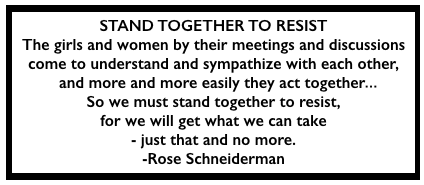 ~~~~~~~~~~~~~~~~~~~~~~~~~
~~~~~~~~~~~~~~~~~~~~~~~~~
Hellraisers Journal – Tuesday January 21, 1913
New York, New York – Photograph of Striking Garment Worker by Lewis Hine
From The Coming Nation of January 18, 1913:
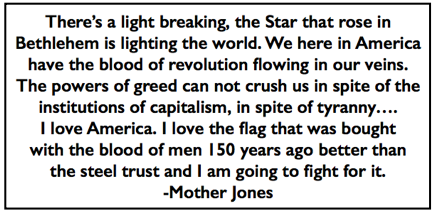 —————
—————
Hellraisers Journal – Wednesday January 15, 1913
“After a few years in the steel mills…..” by Lewis Hine
From The Coming Nation of January 11, 1913:
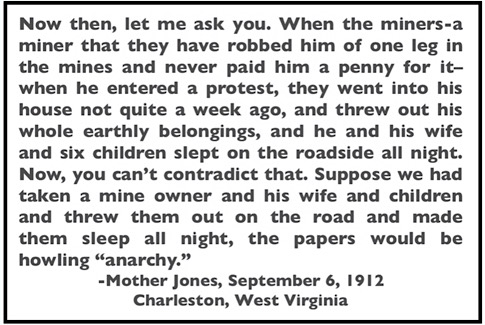 —————
—————
Hellraisers Journal – Monday January 13, 1913
Washington, D. C. – Mother Jones Speaks on Behalf of West Virginia Miners
From the Washington Evening Star of January 11, 1913:
TELLS OF INHUMANITY
———-
“Mother” Jones Scores Treatment of
the West Virginia Coal Miners.
———-
“Mother” Jones, the “angel” of the United Mine Workers and a prominent figure in the coal mining regions for the last forty years, was the principal speaker at a meeting at National Rifles’ Armory last night, the meeting being held under the auspices of the Central Labor Union.
In her address Mother Jones pronounced conditions in the coal mining regions of West Virginia worse than that of the slaves in the darkest days of the antebellum period. She declared that she had seen twenty-one innocent men out of a party of thirty miners slain while they slept by a posse made up of deputy sheriffs and detectives, and that of her own knowledge women and children of striking miners had been thrown out of their cabins, in evil weather, by the hired officers of the mine owners and forced to seek shelter under trees and in eaves of the mountains, without food for four days and nights.
“Were these things to occur in Russia or Mexico,” declared Mother Jones, “the American people would rise up in protest, as they have done on several occasions, forcing Congress to take action to prevent further murders and violence.”
Representative W. B. Wilson of Pennsylvania, for many years a high official of the United Mine Workers, presided at the meeting, and declared that he knew personally that the things of which Mother Jones told were actually true. Other speakers were J. W. Brown of the U. M. W., and Frank Hayes, a vice president of that organization. Resolutions were adopted reciting at length the alleged conditions in the West Virginia coal fields and petitioning Congress to rectify them by adopting a pending of Representative Wilson’s calling for a thorough investigation.
[Photograph and emphasis added.]
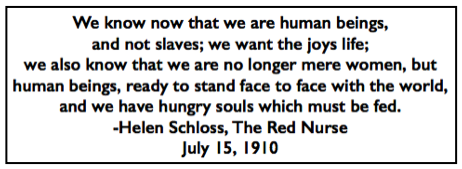 —————
—————
Hellraisers Journal – Wednesday January 8, 1913
Schenectady, New York – Socialist Take in Children of Little Falls Strikers
From The Coming Nation of January 4, 1913:
Detail:
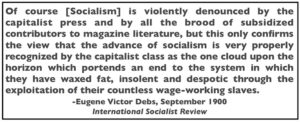 —————
—————
Hellraisers Journal – Monday December 30, 1912
Capitalism and the Plute Press, a Cartoon by Ryan Walker
From The Coming Nation of December 28, 1912:
Continue reading “Hellraisers Journal: Capitalism and the Plute Press, a Cartoon by Ryan Walker”
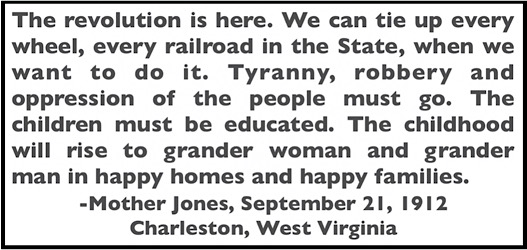 —————
—————
Hellraisers Journal – Monday December 23, 1912
American Flag Stands Tall Over Miners’ Tent Colony at Eskdale, West Virginia
From The Coming Nation of December 7, 1912:
Winning the Fight at Eskdale
———-By Alfred Segal
———-
THERE was a tremendous excitement in the little village of Eskdale, W. Va.
An American flag waves over the main street of Eskdale (perhaps to give assurance that Eskdale is really in America and not in Russia); but on the same street you see little children barefoot, now in November, because they haven’t any shoes, and you see the families of striking miners, evicted and driven into the highways by the Coal Dukes, living under tents because they have no homes. You are ashamed to enjoy the meager comforts of your hotel room after you have lived a day with the misery of Eskdale.
Two rods from the tents stand the coal hills with their fabulous wealth-the fine tables set by nature for all her children and yet within sight of the feast they are starving.
Well, the heart of Eskdale was beating like a trip-hammer. Word had come down through the hills that the governor had declared martial law over the strike district and that the soldiers were coming.
The echoes of gun-shots were rolling down into the valley. They came into Eskdale like the rumble of cannon. Somewhere up in the hills there was another battle on between miners and mine guards-one of those fights that make the quickly-dug, rude graves that you can find in lonely places in the coal hills.
Oh, yes, it’s lawlessness all right. But you can see it and hear it and some people can understand it. For years and years West Virginia has been ruled by respectable, invisible lawlessness which controlled courts, ran the legislatures and elected United States senators and is now responsible for the barefoot little children and the homeless exiles in the tents.
The soldiers were coming.
It runs through Eskdale’s mind that what it wants is a living wage, justice and fair-dealing and here the governor was sending the soldiers.
The shot echoes crashed without pause down the valley, waking sleeping babies under the tents and arousing strange stirrings in the hearts of the men and women of Eskdale, needing bread, but hungering only for freedom.
And then the distant toot of the engine which was pulling the martial law special and the soldiers, broke upon the village. Eskdale crowded to the railroad track. The train rumbled past toward the depot.
In the first car were the soldiers, guns held firmly in front of them, ready for work.
And in the second car-
“Scab, scab,” cried a boy, shrill-voiced.
He pointed at a window in the second car-at a face, soiled, weary-eyed, unshaven, crowned with a battered hat. And behind this face there was another and another-a whole car-load of such faces.
“Scab, scab”-the men and women took up the cry. They could not understand that these men were like themselves the dupes of the system.
Martial law had come into the strike zone with a shipment of strike-breakers whom it was protecting, with orders to shoot to kill if one of them was molested. The state of West Virginia had become a strike-breaking agency.
And to the inhabitants of its hills, the state had given so little protection through all these years. They had asked for laws that would emancipate them from the tyranny of the mine guard system-and had been denied. They had asked for compensation laws that would protect their families against the consequences of fatal accident in the mines-and had been denied.
And here were the strike-breakers come to take their jobs and to live upon their hills under protection of their militia.
“Scab, scab,” they jeered.
[Hunger Squad Pitched Against Hunger Squad]
I was there and spoke to the strike-breakers-men and boys recruited from the hunger squads of the East Side of New York, none of them miners, weary with the futile search for work at their trades, and desperate enough to throw themselves at adventure as strike-breakers for the sake of a job.
The despair of hunger, you see, knows no state lines. It recruits the strike-breaker in New York. It scourges to violence the striking miner of West Virginia. Hunger squad is pitched against hunger squad.